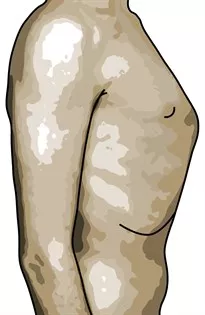Chest Wall Deformities
Chest wall deformities, or abnormal development and appearance of the chest, can vary from mild to severe. These deformities are considered to be congenital and may be apparent at birth or later in childhood. Regardless, the severity of the malformation usually progresses rapidly during puberty. A variety of anomalies are described however the most common are pectus excavatum (sunken chest or funnel chest) or pectus carinatum (pigeon chest). Less common types of chest wall abnormalities include pectus arcuatum, Jeune syndrome, and defects of the ribs and sternum.
Pectus Excavatum

Pectus excavatum is characterized by a depression in the sternum, typically the lower half of the sternum. The depression of the sternum causes cardiac compression and lung capacity restriction. When severe, patients may experience shortness of breath, chest pain, and asthma-like symptoms. The malformation may also cause poor body self-image for patients.
For more information read our Pectus Excavatum page.
Pectus Carinatum

Pectus carinatum is characterized by a protrusion of the sternum that occurs as a result of an abnormal and unequal growth of the costal cartilages connecting the ribs to the sternum. Rather than growing symmetrically along the chest wall, the costal cartilages over grow outward, pushing the sternum forward.
For more information read out Pectus Carinatum page.
Other types of chest wall deformities
Jeune Syndrome is a form of congenital dwarfism that leads to a chest wall deformity; the chest is extremely small. The ribs are often abnormal, broad, short and irregularly joined to the costal cartilages and sternum. This produces a small bell-shaped, inflexible chest cavity, which doesn't grow well and makes breathing difficult. Symptoms may begin in the newborn period, up to 4–5 years of age and can range from mild to severe. The most severe form may make breathing very difficult and the child may require help from a mechanical ventilator.
Poland Syndrome consists of a spectrum of abnormalities of one side of the chest including the absence of the pectoralis muscle(s), under development of breast tissue and areola, rib abnormalities and, in some cases, inadequate development of the arm, hand, and fingers of the same side. The right side of the body is affected twice as often as the left. It is not known how many individuals are affected by Poland syndrome, since mild cases may go undiagnosed. Poland syndrome affects males more commonly than females.
Primary rib anomalies can be the cause of chest wall deformities. There are 12 pairs of ribs that connect to the vertebra. Ribs 1 through 10 connect in the back and to the sternum on the front of the chest, by segments of cartilage. Rib abnormalities are variable and include extra or absent ribs, and partially developed or fused ribs.
Other chest wall deformities are the result of abnormalities in the growth and development of the sternum, such as in pectus arcuatum and sternal cleft.
